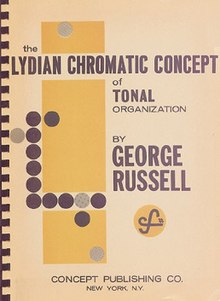Lydian Chromatic Concept of Tonal Organization

First edition cover
|
|
| Author | George Russell |
|---|---|
| Country | United States |
| Language | English |
| Subject | Music theory |
| Genre | Non-fiction |
| Published | 1953 |
| Publisher | Concept Publishing Co. |
| Media type | |
| Pages | 252 pp. |
| ISBN | |
| OCLC | 18406156 |
| Website | lydianchromaticconcept |
The Lydian Chromatic Concept of Tonal Organization is a 1953 jazz music theory book written by George Russell. The book is the founding text of the Lydian Chromatic Concept (LCC), or Lydian Chromatic Theory (LCT). Russell's work postulates that all music is based on the tonal gravity of the Lydian mode.
Russell believed that dominant function was the driving force behind all harmonic motion. Russell focuses on the Lydian mode because it can be built with fifths. For instance, to construct a C lydian scale one could list the first seven tones on the circle of fifths starting with C, the desired Lydian Tonic. This process would yield C, G, D, A, E, B, F♯. If these tones are voiced in the space of an octave, they form the Lydian mode (C, D, E, F♯, G, A, B). Additionally, Russell observed, when these tones are voiced in thirds they form the preferred form of a major 13th chord.
Russell builds a prototype chromatic scale starting on the Lydian Tonic by stacking fifths, skipping the interval between the seventh and eighth tones. Using C as the Lydian Tonic yields the following 12-note scale with enharmonic respellings: C, G, D, A, E, B, F♯,C♯, G♯, D♯(E♭), A♯(B♭), E♯(F), B♯(C). Thus the Lydian Chromatic Scale and all its derivatives contain only Pythagorean intervals.
Russell posited that tonal gravity emanates from the first seven tones of the Lydian mode. As the player ventures further from the Lydian tonic however (and further up the circle of fifths), the tonal gravity shifts. For example, if notes further up the circle of fifths (e.g. ♯2/♭3) are used, the tonal gravity is probably shifting.
...
Wikipedia
